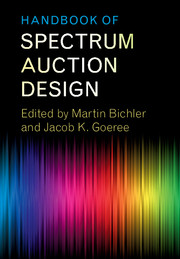Book contents
- Frontmatter
- Contents
- List of Contributors
- Preface
- List of Papers
- Part I The Simultaneous Multiple-Round Auction
- Part II The Combinatorial Clock Auction Designs
- Part III Alternative Auction Designs
- Part IV Experimental Comparisons of Auction Designs
- Part V The Bidders’ Perspective
- Part VI Secondary Markets and Exchanges
- 36 Spectrum Markets: Motivation, Challenges, and Implications
- 37 Designing the US Incentive Auction
- 38 Solving the Station Repacking Problem
- 39 ICE: An Expressive Iterative Combinatorial Exchange
- 40 ACE: A Combinatorial Market Mechanism
- Outlook
- References
37 - Designing the US Incentive Auction
from Part VI - Secondary Markets and Exchanges
Published online by Cambridge University Press: 26 October 2017
- Frontmatter
- Contents
- List of Contributors
- Preface
- List of Papers
- Part I The Simultaneous Multiple-Round Auction
- Part II The Combinatorial Clock Auction Designs
- Part III Alternative Auction Designs
- Part IV Experimental Comparisons of Auction Designs
- Part V The Bidders’ Perspective
- Part VI Secondary Markets and Exchanges
- 36 Spectrum Markets: Motivation, Challenges, and Implications
- 37 Designing the US Incentive Auction
- 38 Solving the Station Repacking Problem
- 39 ICE: An Expressive Iterative Combinatorial Exchange
- 40 ACE: A Combinatorial Market Mechanism
- Outlook
- References
Summary
The US government recently completed a new kind of double auction, which aquired television broadcast rights from current TV broadcasters and sold mobile broadband licenses. Known as the “incentive auction” because it was intended to create an incentive for TV broadcasters to relinquish their licenses, this auction involved tens of billions of dollars of payments and determined an allocation that satisfies millions of interference constraints. In this paper, we describe why the problem is so complex, outline the auction's final design adopted by the Federal Communication Commission, and describe how this design overcame the novel challenges that the FCC faced.
Background and Challenges
The incentive auction was mandated by an act of Congress in February 2012. In the years since the introduction of the iPhone, iPad, and similar devices, there has been explosive growth in the demand for broadband services and the spectrum it uses. The US government responded with its National Broadband Plan, which aims tomakemore spectrum available for broadband services partly by clearing some bands currently in other uses. Some spectrum used for UHF television broadcasts was very well suited to broadband. Since 90% of US households had access to cable or satellite television, over-the-air broadcasting appeared to be less important than in an earlier era. Also, the switch to digital TV signals made it possible to transmit several standard-definition signals using a single TV channel.
The Roles of Government and Auction
Economists naturally ask: Why not just rely on private transactions to shift spectrum resources to their most valuable uses? Why is value added by a government intervention?
The answer is that spectrum reallocation has the characteristics of a collective action problem. In order to use spectrum most effectively, the frequencies used for TV broadcasting need to be nearly the same across the whole country and the wireless broadband uses must be separated from TV frequencies and coordinated to avoid unacceptable interference between uplink and downlink uses.
- Type
- Chapter
- Information
- Handbook of Spectrum Auction Design , pp. 803 - 812Publisher: Cambridge University PressPrint publication year: 2017
References
- 8
- Cited by



